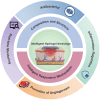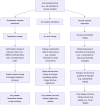Intelligent hydrogel-based dressings for treatment of chronic diabetic wounds
- PMID: 40487617
- PMCID: PMC12142181
- DOI: 10.4239/wjd.v16.i5.104937
Intelligent hydrogel-based dressings for treatment of chronic diabetic wounds
Abstract
Diabetic wounds represent a significant challenge in the medical field, significantly impacting patient quality of life and imposing a heavy burden on healthcare systems. Intelligent hydrogel dressings have attracted significant attention in diabetic wound treatment due to their unique properties. This review systematically explores the three main categories of intelligent hydrogels (natural, synthetic, and composite), dissecting their composition, structure, and the mechanisms that enable their intelligent responses. The crucial roles of these dressings in maintaining a moist wound environment, efficiently absorbing exudate, and precisely delivering drugs are expounded. Moreover, their application advantages in combating bacteria and infections, regulating inflammation and immunity, promoting angiogenesis and tissue regeneration, as well as enabling real-time monitoring and personalized treatment, are explored in depth. Additionally, we discuss future research directions and the prospects for personalized precision medicine in diabetic wound care, aiming to inspire innovation and provide a comprehensive theoretical basis for the development of next-generation intelligent dressings.
Keywords: Diabetic wounds; Drug delivery systems; Hydrogel; Intelligent dressings; Stimuli-responsive polymers.
©The Author(s) 2025. Published by Baishideng Publishing Group Inc. All rights reserved.
Conflict of interest statement
Conflict-of-interest statement: All the authors report no relevant conflicts of interest for this article.
Figures




Similar articles
-
Conductive hydrogels: intelligent dressings for monitoring and healing chronic wounds.Regen Biomater. 2024 Nov 1;12:rbae127. doi: 10.1093/rb/rbae127. eCollection 2025. Regen Biomater. 2024. PMID: 39776855 Free PMC article. Review.
-
Progress of Hydrogel Dressings with Wound Monitoring and Treatment Functions.Gels. 2023 Aug 28;9(9):694. doi: 10.3390/gels9090694. Gels. 2023. PMID: 37754375 Free PMC article. Review.
-
Research advances in smart responsive-hydrogel dressings with potential clinical diabetic wound healing properties.Mil Med Res. 2023 Aug 23;10(1):37. doi: 10.1186/s40779-023-00473-9. Mil Med Res. 2023. PMID: 37608335 Free PMC article. Review.
-
3D Printing-Based Hydrogel Dressings for Wound Healing.Adv Sci (Weinh). 2024 Dec;11(47):e2404580. doi: 10.1002/advs.202404580. Epub 2024 Nov 18. Adv Sci (Weinh). 2024. PMID: 39552255 Free PMC article. Review.
-
[Research advances on multifunctional hydrogel dressings for treatment of diabetic chronic wounds].Zhonghua Shao Shang Za Zhi. 2021 Nov 20;37(11):1090-1098. doi: 10.3760/cma.j.cn501120-20210715-00249. Zhonghua Shao Shang Za Zhi. 2021. PMID: 34794262 Free PMC article. Review. Chinese.
References
-
- MacDonald C, Bennekou M, Midtgaard J, Langberg H, Lieberman D. Why exercise may never be effective medicine: an evolutionary perspective on the efficacy versus effectiveness of exercise in treating type 2 diabetes. Br J Sports Med. 2025;59:118–125. - PubMed
-
- Udler MS. Genetic insights into global heterogeneity of type 2 diabetes. Nat Med. 2025;31:35–36. - PubMed
-
- Huang L, Chen H, Nie J, Zhao Y, Miao J. Advanced dressings based on novel biological targets for diabetic wound healing: A review. Eur J Pharmacol. 2025;987:177201. - PubMed
-
- Sloan L, Cheng AYY, Escalada J, Haluzík M, Mauricio D. The role of basal insulins in the treatment of people with type 2 diabetes and chronic kidney disease: A narrative review. Diabetes Obes Metab. 2024;26:1157–1170. - PubMed
-
- Verde L, Di Lorenzo T, Savastano S, Colao A, Barrea L, Muscogiuri G. Chrononutrition in type 2 diabetes mellitus and obesity: A narrative review. Diabetes Metab Res Rev. 2024;40:e3778. - PubMed
Publication types
LinkOut - more resources
Full Text Sources

